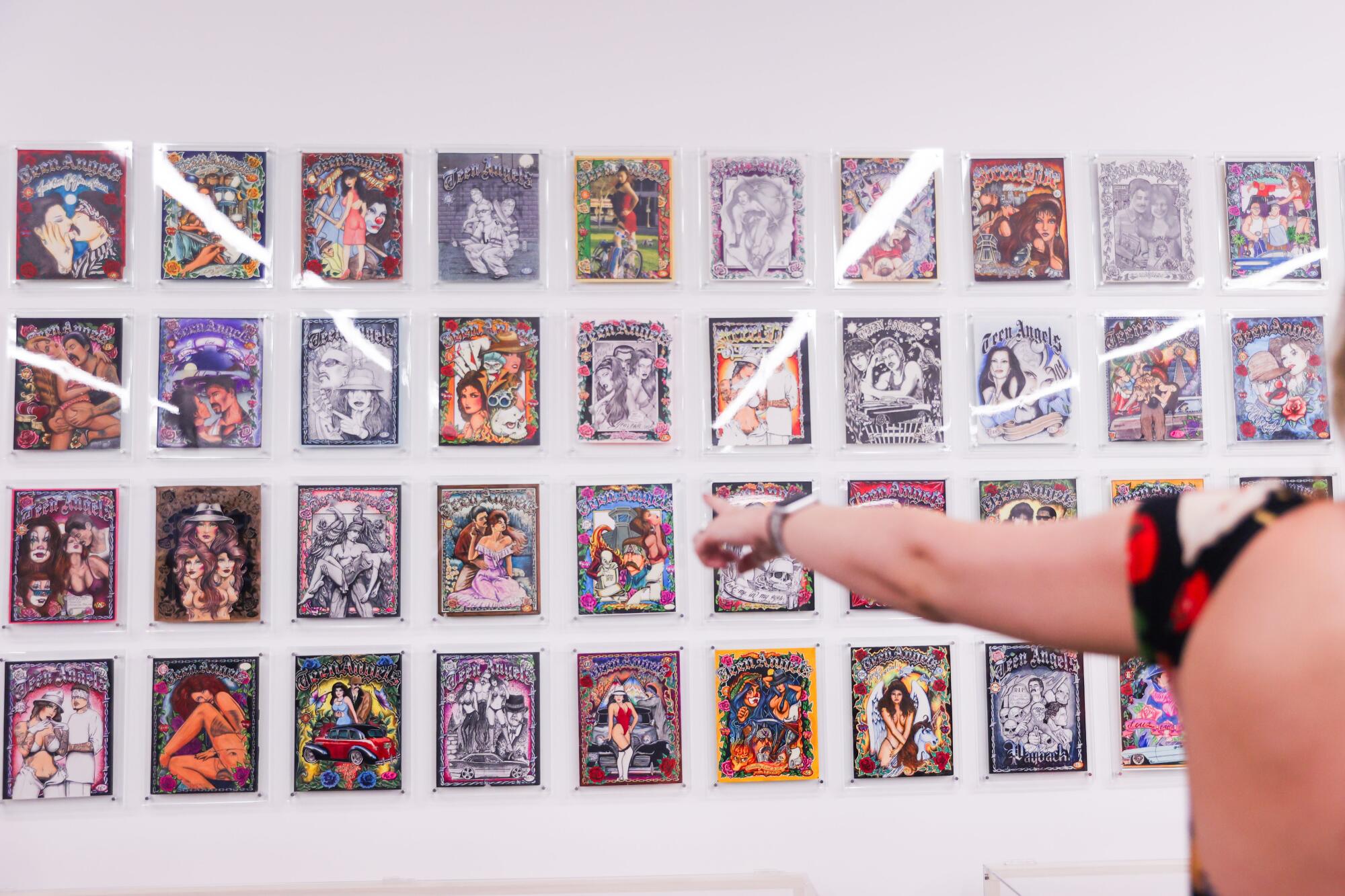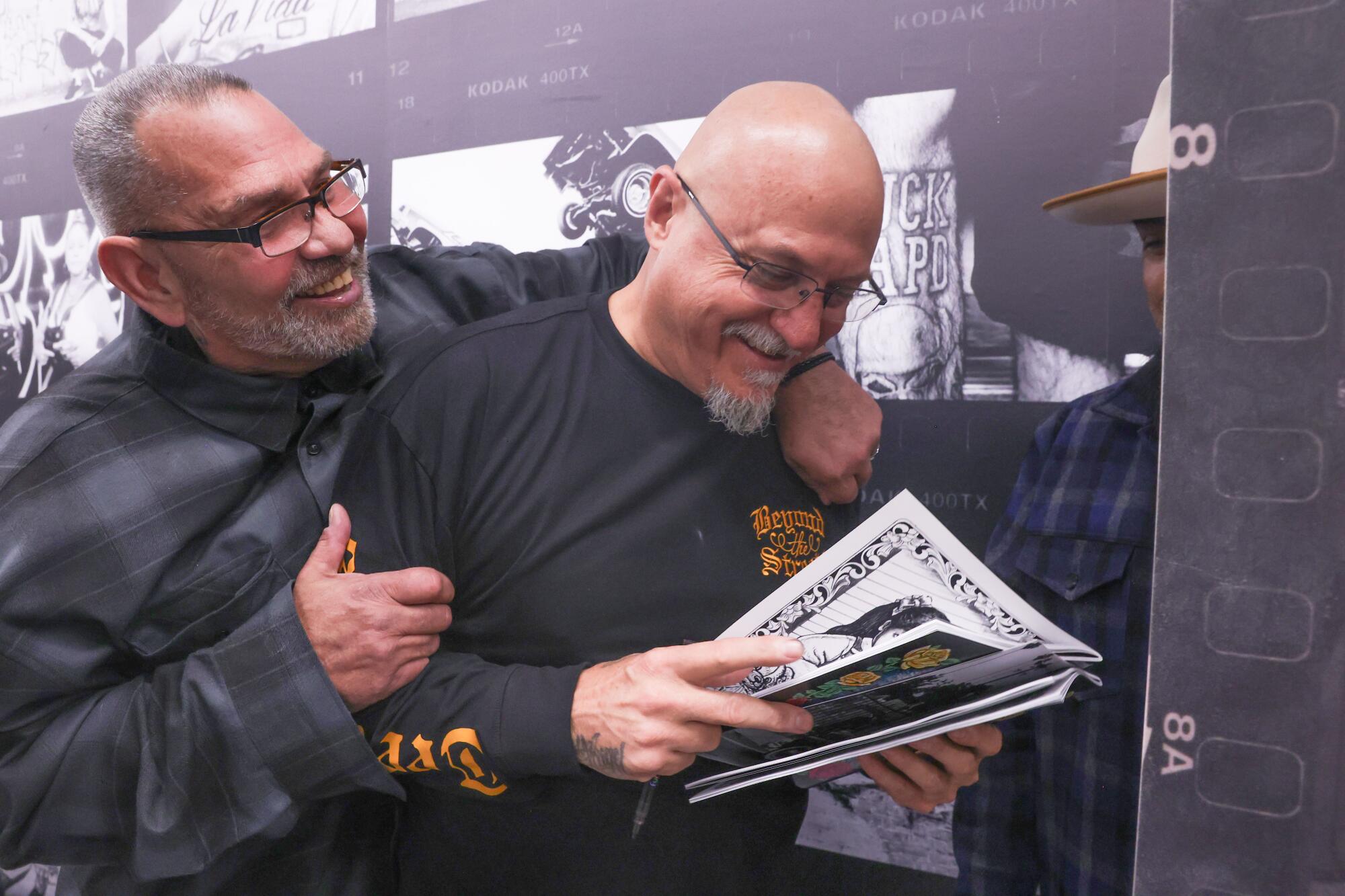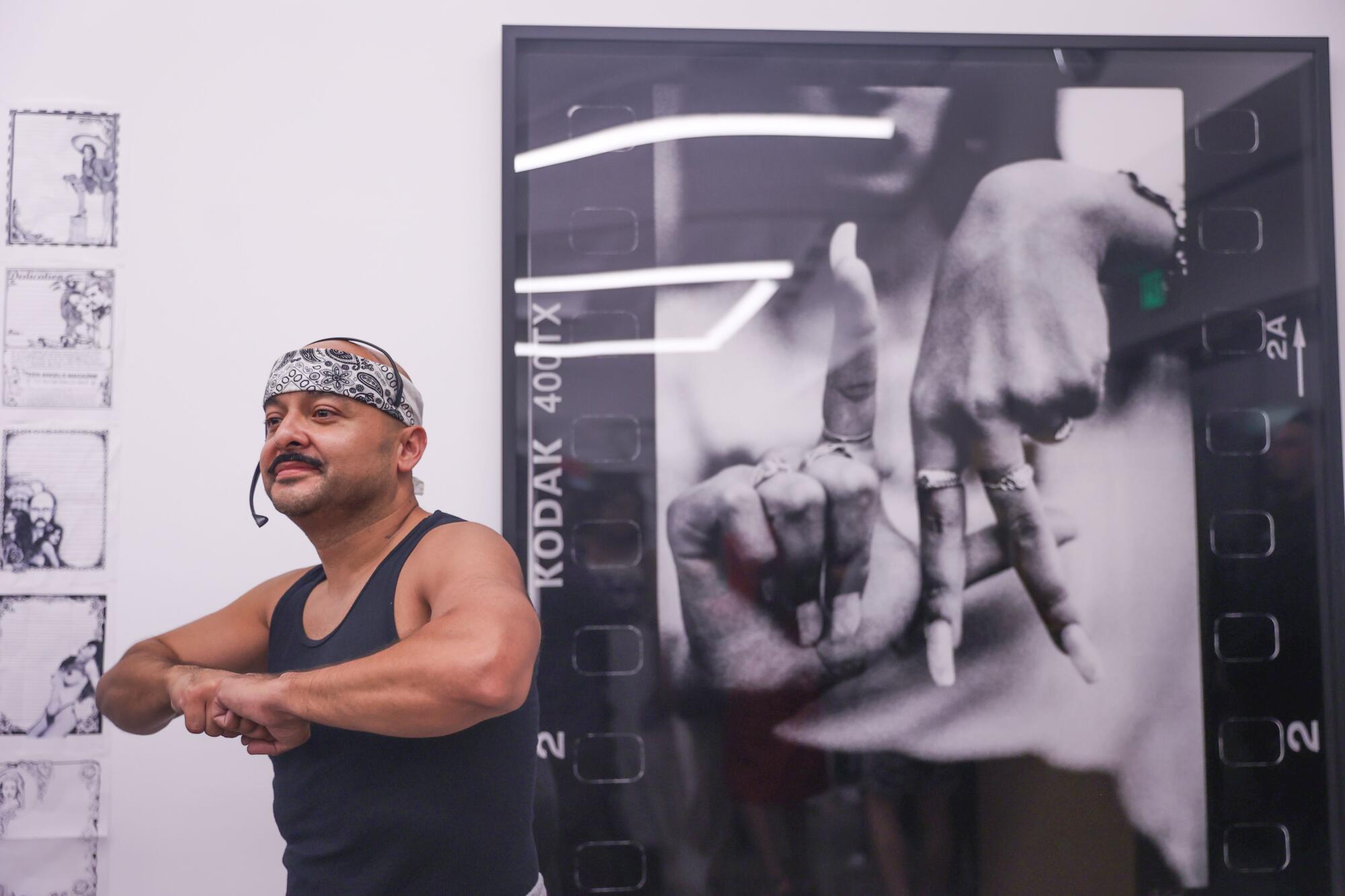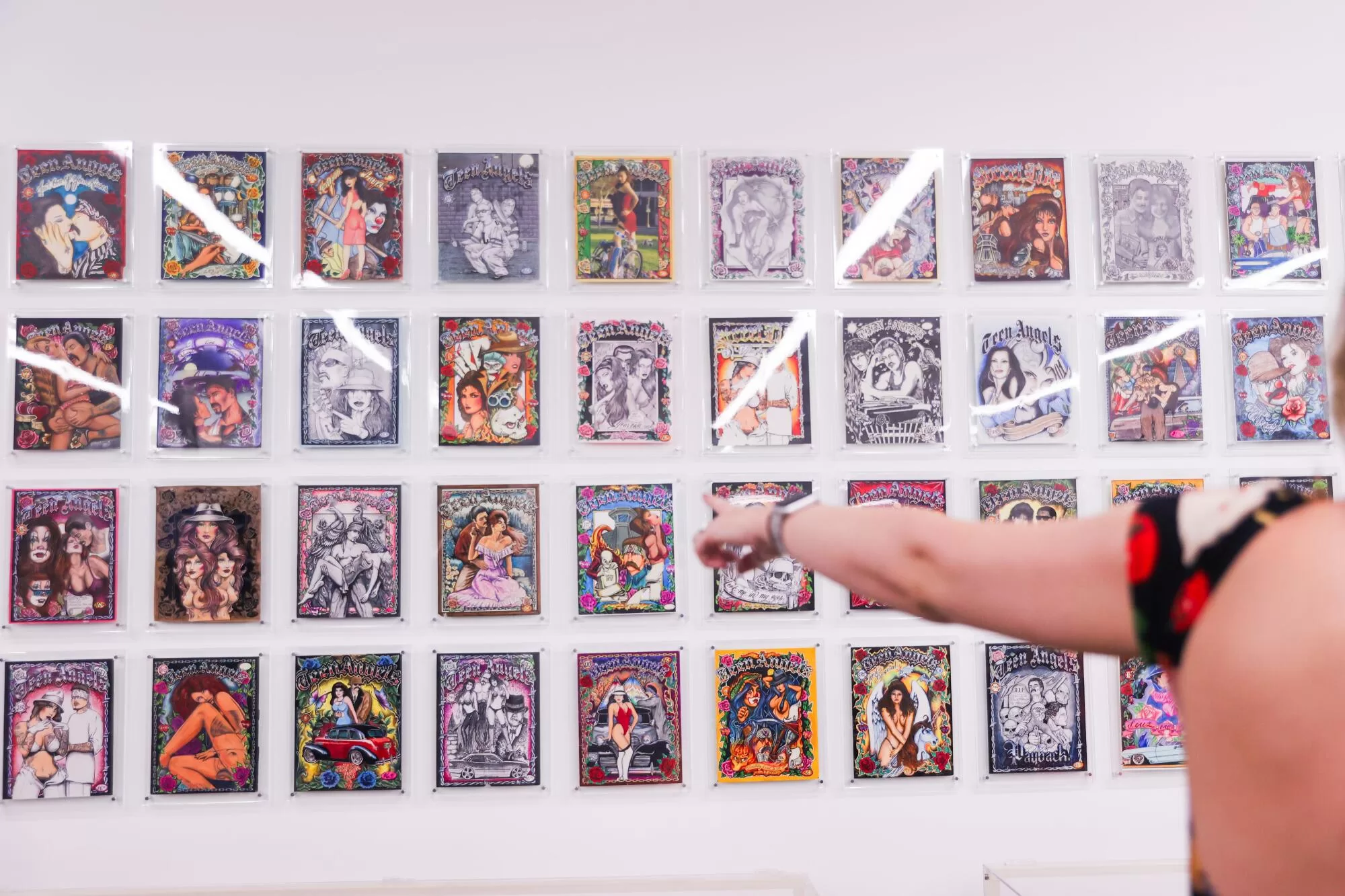Street photographer and artist Estevan Oriol, best known for his image of the “L.A. fingers,” remembers frequenting the corner of Fourth and Soto streets in Boyle Heights in the 1990s to pick up the latest issue Teen Angel, an art zine named after its creator that portrayed Chicano life. Oriol felt the magazine’s subject matter mirrored his own work — he was using his camera lens to capture Chicano life while Angel did it with his colorful, hand-drawn illustrations.
Now, the work of both artists is on display in “Dedicated to You,” a new exhibition at Melrose gallery Beyond the Streets.
Open until Sept. 15, the show explores the various intersections between two artists’ bodies of work while doubling as a window into L.A.’s youth Chicano culture of the 1990s and early 2000s. On display are photographs, drawings and artifacts that provide an often neglected history of the city that raised them. The exhibit allows for their work to come together in depicting a rich vignette of “the culture.”

Guest look at past issues of Teen Angel magazine during the “Dedicated to You” opening.
(Michael Blackshire/Los Angeles Times)
Same time, same place
Oriol, 57, says he doesn’t consider himself to be inspired by Angel but someone who was experiencing the same city concurrently.
“It was cool because, at that time, I was shooting all that kind of stuff like the homies, the lowriders and the girls. I was right there side by side doing what was in the magazine,” said Oriol.
On the gallery’s opening night, a line of vintage lowriders and motorcycles lined La Brea Avenue. The show’s poster, a large black and white image of a young Chicano couple kissing, acted as a background to the impromptu car show.
Within the gallery’s glass walls are Oriol’s negative contact sheets. The film rolls depict old Echo Park gang graffiti, lowriders caught mid bounce, tattooed women, and shots of celebrities like Snoop Dogg and Danny Trejo.
Born in Santa Monica, Oriol says he got his first taste of Hollywood after he began working as a doorman for several L.A. nightclubs in the ‘80s The job allowed him to connect with hip-hop groups like Cypress Hill, Boo-Yaa T.R.I.B.E. and Rhyme Syndicate.
“Everybody would mix at these clubs. You would see some break dancers here and some new wavers there,” he said. “There were cholos and rockers with crazy hairspray looks. We were all just starting. Everything was new and fresh.”
Oriol eventually landed a job as a tour manager for hip-hop group House of Pain. Around the same time, Oriol’s dad gave him a camera.
“My dad told me to start shooting all the stuff that you’re around,” Oriol said. “At that time, I was also building a lowrider and I was in a car club in East L.A. We used to have our meetings on Beverly and Atlantic at the Mobil gas station.”
Every Friday, Oriol would cruise all around Los Angeles, from Whittier Boulevard to Hollywood Boulevard — along the way he snapped photos.
“It wasn’t just showing up and taking pictures of something that I wasn’t a part of,” Oriol said. “I’m not an outsider. A lot of photographers who don’t come from the culture and take pictures of it say they want to do their own narrative. I’m not trying to do that. It is what it is. I just shoot what I see.”
Visitors of the gallery are met with several glass cases with relics from both Oriol and Angel’s lives — an arsenal of Oriol’s cameras fills the shelves, along with several pairs of Nike Cortez sneakers hanging from a wire, memorial candles and a hubcap from one of his first cars.
Angel’s display is centered on the very desk and chair where he created the magazine, complete with cigarette burns and paint splatters. Images of his workspace and home the day after his passing sit atop the desk. When Angel died in 2015, Oriol, despite never having met him, was invited to come take pictures of how he left everything. On both sides of the desk, more parts of his private life can be seen including his glasses, a model ship and several figurines of his popular drawings.

Estevan Oriol is embraced by OG Lepke, whom he took many photos of, during the opening day of the gallery exhibit.
(Michael Blackshire/Los Angeles Times)
The man behind the magazine
Born Dave Holland in Indiana, the reclusive Angel chased his obsession with old Chevys to Southern California in the 1970s, landing a job as an illustrator for Lowrider magazine. In 1980, he founded Teen Angel, which focused on publishing artwork by the incarcerated and putting a spotlight on what Chicano culture looked like at the time.
David De Baca, one of Angel’s closest friends who is now manager of his estate, helped curate the show at Beyond the Streets. He says seeing Oriol’s work paired with Angel’s is something that always made sense to him.
“Estevan sees beauty in these neighborhoods and he photographs it. And in the same sense, that’s the way Teen Angel was,” De Baca said. “He saw beauty in the neighborhood and through his magazine, you would see drawings of cholos and cholas and street scenes of a neighborhood where it was a little gritty and there’s graffiti on the wall. But, when it’s laid out appropriately in artwork, you see the beauty in it. He and Estevan always saw the same kind of beauty.”
A bookshelf, complete with every issue of Teen Angel, is positioned next to a wall featuring the magazine’s original cover art and other works. The complete collection belongs to Bryan Ray Turcotte, who has spent the last decade hunting down every issue. As a skater kid involved in the DIY scene, Turcotte says the publication was very meaningful in his adolescence.
“[Teen Angel] was so haphazard about his numbering system,” said Turcotte of amassing his collection. “There’s all these offshoots of magazines that popped up in the middle of the run, so I had to do massive amounts of research to figure out how many there actually were.”

Frankie Quinones poses in front of Oriol’s “L.A. Fingers.”
(Michael Blackshire/Los Angeles Times)
Rooted in dedication
One wall at the gallery is devoted to “Silent Signals,” a recurring series in the magazine that featured various hand signals meant to discreetly communicate with a romantic interest. His signature “Traviesa Twins,” reoccurring characters in the issues, hold up different signs that communicate the alphabet. Next to each of Angel’s drawings, Oriol puts a modern-day twist on the signals by taking photos of Latinas mirroring the twins. Together, the wall acts as a connection point between Teen Angel’s drawings from 43 years ago to today’s culture.
In the neighboring room, massive vinyl cutouts of Angel’s drawings fill the gaps between Oriol’s prints, including “L.A. Fingers.” To the photographer, the show is all about making the viewer feel something. But when he walks through the gallery himself, he gets “pissed off.”
“I start to think of all the pictures that I didn’t take,” Oriol said. “Or the days that I f—ing didn’t have my camera or I think about how I had my camera and I didn’t take a picture of something, like what a f—ing idiot.”
Despite never having met, dedication lies at the center of everything Angel created and Oriol continues to create.
“It’s dedicated to the West Coast,” Oriol said. “It’s dedicated to the homies that passed away. It’s dedicated to everyone who’s part of this or however you want to put it. For me, it’s dedicated to this city.”
